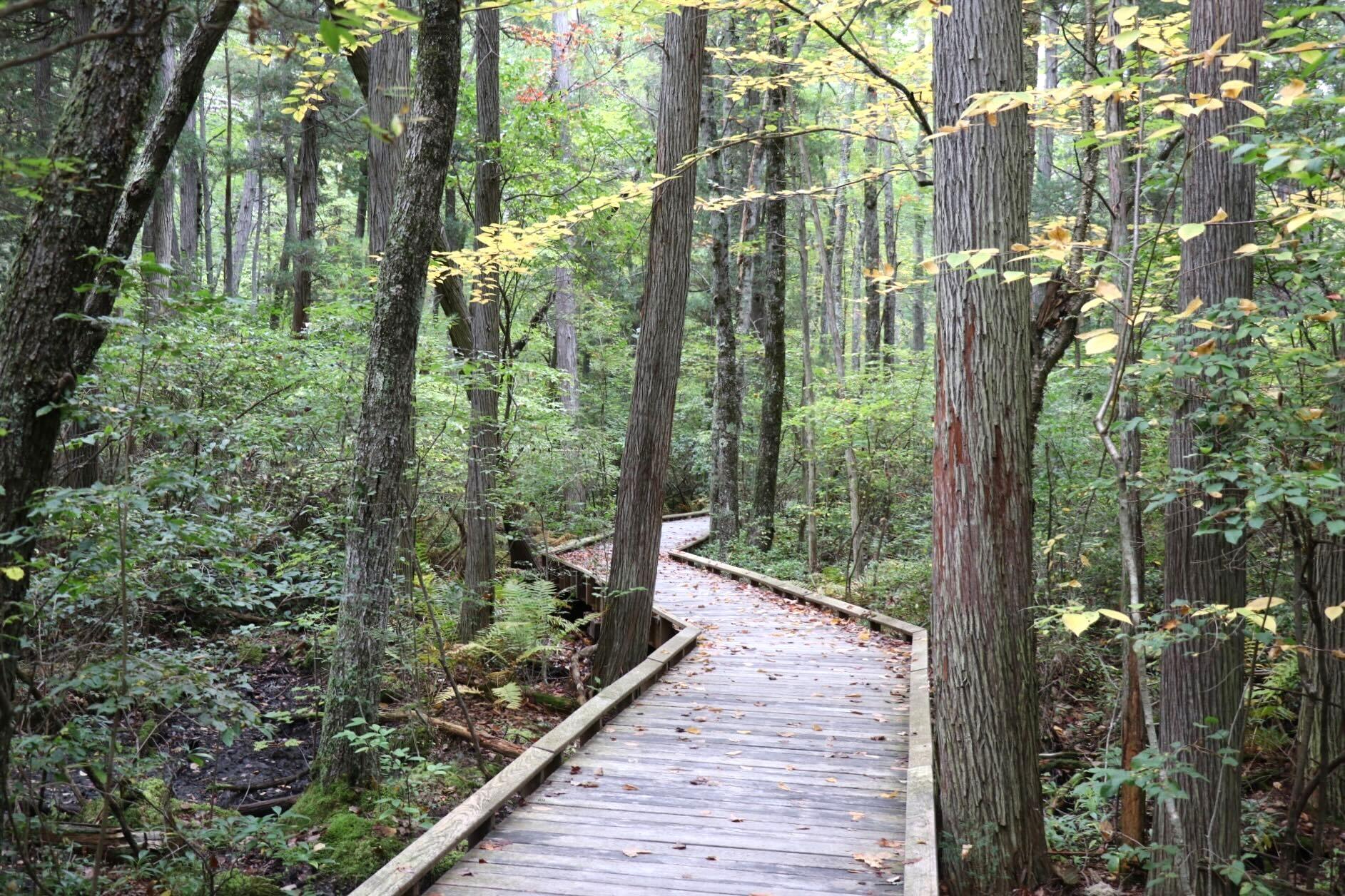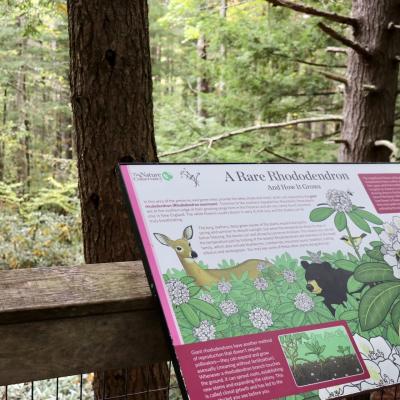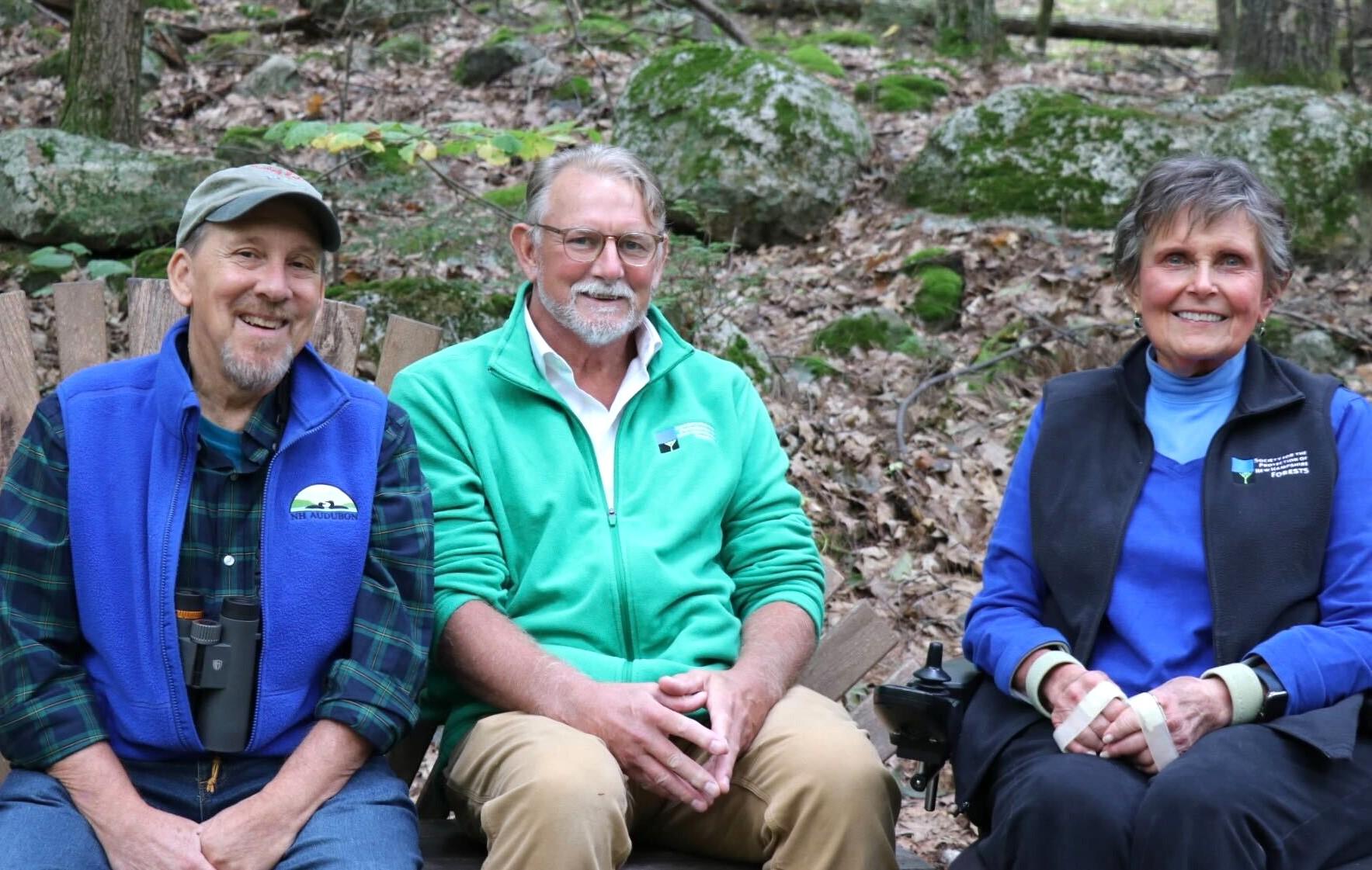- Tags:
- Something Wild,
- Recreation,
- Wildlife

A boardwalk at the Manchester Cedar Swamp.
Something Wild is at the Nature Conservancy’s Manchester Cedar Swamp Preserve, as we continue our series exploring thoughtfully designed hiking trails that allow people of varying ability to access our state's natural beauty.

We are with Janet Zeller, a Forest Society trustee and outdoor enthusiast. Zeller was the U.S. Forest Service National Program Manager for Accessibility, and helped to write the accessibility standards adopted by the U.S. Forest Service for their 182,000 miles of trails nationwide.
Before we head out on the All Persons Trail, we are interrupted by the sound of air brakes. It’s a Manchester City bus making a stop at the trailhead parking lot. “Route 11 of the Manchester bus system stops here,” says Janet. This allows hikers from downtown Manchester to visit the Manchester Cedar Swamp Preserve even if they don't have a vehicle.
At 640 acres, the Manchester Cedar Swamp Preserve is the largest protected block of conservation land in the city of Manchester. It contains some special forest communities that we will visit as we discuss inclusive trail design.

“I was very tempted to bring my manual chair because walkers really don't feel the change. It all blends in” says Zeller. As we walk the trail, she points out the gradual elevation and switchbacks that protect against erosion.
“You're really doing quite a lot of elevation, but you're doing it in such gradual little pieces,” she says. “You have no idea what's directly around this corner. To keep the water off the trail, you go with the ups and downs and the curves around trees and rocks at the same time. It makes for a much more interesting trail. It's all about keeping the water off the trail because water on the trail means erosion every single time.”
Zeller emphasizes that inclusive, sustainable trails are about creating engaging trails that everyone can enjoy while preserving the natural environment. She has worked closely with the professional trail building team of Peter Jensen and Associates, who built the Manchester Cedar Swamp All Persons Trail as well as the Crotched Mountain Accessible Trails in Greenfield.
Zeller prefers the term sustainable trails for all, or all persons trails, instead of accessible trails. “The term accessible limits you a great deal,” she says. “We have learned over the years that the public perceives the term “accessible trail” to be flat and paved. Avid hikers think that's not very interesting and don't want to bother with it…so if you can lose the word accessible and help folks understand: it's an interesting trail.”

We reach an outlook perched on a hillside over a grove of rhododendrons, with enough elevation to be looking down the hillside. “What a fantastic view of these rhododendrons from above,” Martin says. “It's a view you don't usually get of them.”
These are giant rhododendrons, rhododendron maximum, a native rhododendron. Here, it's at the northern limit of its range.
Zeller points out the features of the overlook that might not catch your attention, such as the wire grid that allows her to view the rhododendrons while seated. “If you put horizontal boards, children see that as a ladder. And the vertical boards really tend to block this [view]. You see the full view right through it. But you've still got your safety.”
She also notes the accessible benches here and along the trail. “A person who uses a wheelchair could back in and transfer to it and sit or sit shoulder to shoulder with their friends,” she says, noting the ends of the bench are armless. “If you need an arm when you sit, you sit toward the middle because there's an arm there.”
After more exploration of the trail, we reach the approximately 250-foot boardwalk through the swamp, which features species adapted to growing in wet conditions.
“It's awesome,” says Anderson. “Northern white cedar grows in wetlands in northern New Hampshire, and then there's coastal Atlantic cedar that grows along the coast. And those forests have been impacted by human development all along the Atlantic seaboard due to people building.”
According to the Nature Conservancy, Atlantic white cedar wetlands are considered a globally threatened ecosystem due to centuries of development as well as sea level rise accelerated by climate change. Cedar was heavily harvested because it is highly resistant to rot and was especially prized for building. In the colonial era, they were even hollowed out for use as pipes to convey water.
The swamp is also home to the relatively rare black gum tree. Also called tupelo, it's one of the slowest-growing and longest-lived trees. Anderson estimates that the trees in the swamp could be 500 years old, and only halfway through their lifetime. They are adapted to wetlands and often found in “pocket wetlands” on hillsides.
After leaving the boardwalk, Martin reflects that it allows access to an area we would not otherwise not be able to visit and appreciate. “On the one hand, the Nature Conservancy is trying to conserve and protect the habitat,” he says. “And yet we want people to get out and see it, because if you don't get out and see it, you are likely to appreciate it less. So getting people out in the environment is really important. That's why this trail is so important.”
Some of the things that make a trail sustainable, and prevent water from eroding it, allow it to sit more lightly on the environment. They also make a trail more inclusive.
“The emphasis today when you're building trails is: are they sustainable?” says Zeller. “Are they going to stay put after I put it there and have low maintenance? And are they going to serve all to the extent possible without changing the natural setting, the environment?”
Something Wild is a joint production of NH Audubon, the Forest Society, and NHPR.
